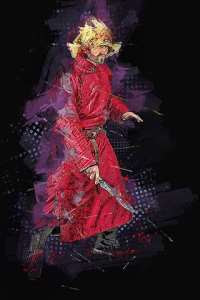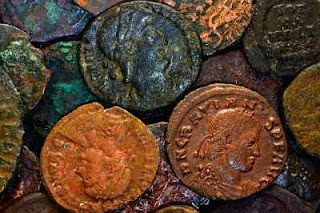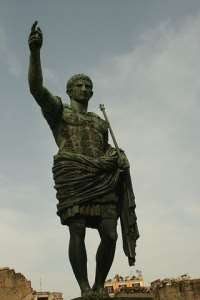Norman Sack of Rome 1084 : Life History
Norman Sack of Rome 1084 :Life History
Norman Sack of Rome
In the spring of 1082, the great Fortressof Dyrrachium had fallen, and Byzantium’s Balkan defences were in shambles. The old Fox Guiscard had left his son in chargeof the Byzantine campaign, himself having returned to Italy to rescue the Pope fromthe ambitions of the German King. In Greece, the showdown between an untestedyoung Norman warlord and the cunning Eastern Roman Emperor would decide the fate of theEastern Rome, while the old Fox’s final romp in Italy would cement the Normans’legacy in the Catholic west. taking the city of Castoria with ease, wherethey rested and prepared an offensive on Alexios’ temporary base of Thessaloniki.
In April, word of the brewing revolts in Apuliareached Duke Robert, and the old warlord hastily departed back home to quell the rebellion,setting the stage for the coming contest between Bohemond and the Byzantine Emperor AlexiosI Komnenos, who despite being bloodied, was not ready to throw in the towel. Surprisingly, Bohemonds’ first course ofaction was not to strike at Thessaloniki as his father had planned, but to take his troopsand march southwest to the capital of Epirus, Ioannina. On his way through Thessaly, he found hisarmies supplemented by the local Vlachs, a collection of peoples who existed in pocketsthroughout the Balkans. These Aromanians, as they were also known,had been chafing under the heavy taxation and corrupt bureaucracy of the Byzantine empirefor decades, and saw common cause with the Normans.
By the end of April, Bohemond’s army hadreached Ioannina. The city quickly surrendered to spare itselffrom the ruthless pillaging that the Normans were infamous for. Bohemond spent the next few months fortifyingits defenses. Meanwhile, Alexios had retreated to Constantinople,where he had managed to scrape together a new army despite depleted resources. The total size of this army is lost to history,but it likely outnumbered Bohemonds’ expeditionary force.
Some time in the summer, Alexios’ host hadarrived in the hinterlands just outside Ioannina. The shrewd Emperor had learned from his lossat Dyrrachium. To counteract the thundering impact of a Norman cavalry charge, he had a squadron of light chariots hidden behind a front line of infantry,with riders hiding beneath the vehicles. The plan was to lead the Normans into believingthat the Byzantines were a primarily foot-soldier based army, prompting them to commit to afull-scale charge. When the enemy knights came within strikingdistance, the front line would split and the riders would rush onto their chariots, usingtheir superior mobility to outmaneuver, flank and destroy.
This however, would never come to pass. Bohemond evidently had learned of the Greeks’plans beforehand, and responded simply by dividing his cavalry into two wings, charginginto the Byzantine forces’ left and right flank to catch them in a pincer movement,rendering them unable to maneuver around them.
Caught entirely by surprise, most of Alexios’army fled the field, while many were slaughtered in a brutal Melee. Ioannina remained in Norman hands. Humiliated once more, Alexios limped backto Thessaloniki, where he consolidated what remained of his levies, all the while confiscatingthe treasures of the Orthodox church. This was deeply unpopular with the clergy,but it allowed the Emperor to replenish his army with mercenaries. Bohemond, meanwhile, had marched his victoriousforces southwards to the city of Arta, which he laid siege to.
Just like Dyrra chium and Ioannina, Alexios marched once more to relieve the latest city that had fallen into Norman clutches. Once more, he predicted a full-frontal cavalrycharge, and this time laid a perimeter of caltrops hidden in the tall grass ways aheadof his front line. His plan was to use the traps to pierce the Norman horses’ flesh, throwing them into chaos, at which point the Byzantine lightcavalry, situated on the wings, would charge into their left and right flank. Bohemond however, was of a simpler mind. Deciding to simply use what had worked before,he once more divided his knights into a left and right wing, barreling into the Byzantine forces in a pincer yet again, by passing the caltrops which had only been laid before thefront lines.
Furthermore, Alexios’ had not accountedfor his army’s low morale. Terrified of the Normans’ who thus far hadmade mincemeat of them in every battle they fought, the Greeks and their mercenaries eitherfled the field or were slaughtered. Seeing yet another battle lost, Alexios fledback to Constantinople. With Alexios’ stuck licking his wounds inhis capital, Bohemond took the initiative and advanced northeast, subduing the cityof Skopje and the surrounding towns, before marching back south to Castoria by mid-Autumn. With the weather turning bleak, the young Norman warlord had to make a choice: settle in for the winter or continue his advance.
Knowing the climate of western Macedonia tobe chilly and damp, and not wanting to risk sickness spreading through his army, Bohemonddecided to push south-east, to the sunny, fertile plains of Thessaly. To that end, the Norman knights pointed theirlances at the regions’ capital, the city of Larissa. If Byzantine sources are to be believed, the Franco-Norsemen appeared before the walls of Larissa on November 3rd, laying siege tothe city and cutting it off from the outside world. The city defense was headed by a veteran soldiernamed Leo Cephalas, who remained ardently loyal to his Emperor in Constantinople. Leo defiantly held out against Bohemond forover six months, but as winter turned to spring, morale in the city began to plummet as theLarissans starved under the Norman blockade.
Meanwhile, Emperor Alexios, predictably, hadnot yet given up. Despite suffering crushing loss after crushingloss, the remarkably stubborn Roman would not turn his back on his dying Empire. First he resorted to diplomacy. Using the same underhanded tactics that hadsent Guiscard rushing back to Italy, he found a way to spread whispers into the Norman camp,lighting the fires of conspiracy. Three senior generals in the Norman army,Peter of Aulps, and two men named Renaldus and William, were accused by the rest of the Franco-Norsemen of scheming to defect to the Byzantines. This created a rift within Bohemond’s leadershipcore, no doubt dealing a blow to Norman morale, and buying Alexios some time. Meanwhile, using what remained of Byzantinecoffers and confiscated Church artifacts, Alexios managed to purchase for himself amercenary army of 7,000 Seljuk Turks, loaned to him by the Rum Sultan, Suleiman I. Despite being the recent enemies of the EasternRomans, it can be surmised that the Turks had a vested interest in ensuring that anarmy of zealous Latin Knights did not advance right onto their doorstep.
In March of 1083, Alexios began his westwardmarch for one final, decisive battle with the Normans. Joined by Greek levies from Thessaloniki andsome Pecheneg sellswords on the way, he passed his army through the narrow Tempe valley,and via the river Peneus, making his camp in the town of Trikala, where he began formulatinghis plan of attack. With each defeat, Alexios had adapted hisstrategy, and this time was no different. He knew that his troops were comparativelylow in experience and morale compared to the veteran, battle-hardened Norman knights, andthat therefore any direct confrontation with the Latin enemy would result in yet anothercrushing loss. To that end, he apprehended a local Thessalianfarmer and had him educate his generals on every detail of the local terrain, with theintention of planning an ambush.
On a sunny summer’s morning, sometime inJuly of 1083, a line of Byzantine soldiers appeared on the plains of Larissa’s easternapproach. Led by the generals Nicephorus Melissinusand Basil Curticius, their Imperial banners flew proudly, challenging the Normans to fight. Believing the flags to represent the mainRoman army, Bohemond immediately ordered his knights to mount up. With himself at the head of one squadron,and his trusted officer Brienne at the other, they barreled down in a full frontal cavalrycharge upon the Byzantine line.
This time, however, would not be like theothers. Instead of engaging in a general melee, theByzantines began a planned retreat to a place called Lykostomion: The Wolf’s Mouth. It was here Alexios’ genius finally pulledthrough. Setting his ambush into action, the Greek Emperor ordered a contingent of mounted archers and peltasts to begin harassing the charging Norman knights from the flank, prompting them to break their pursuit. This worked like a charm, as Count Briennepeeled off his squadron of knights to charge at his harassers. Unfortunately for him, the Normans’ heavycavalry proved unable to outmaneuver the likely Turkic mounted archers, who circled aroundthem with ease, shooting out the horses from under the Latin Knights, and raining chaosupon them. Brienne made a desperate attempt to call forreinforcements, but he had been separated from Bohemonds’ squadron and communicationlines had been cut. Meanwhile, Bohemond himself had broken offhis pursuit of the Byzantine decoy army, and made a temporary camp on a small river-islandcalled Salabria, a narrow region on the outskirts of Larissa defined by marshy swamplands.
According to Byzantine sources, Bohemond didnot take his situation very seriously, reportedly having been lounging around eating grapes. Some time later, Briennes’ squadron hadlikely managed to link back up with Bohemond, and their ragged, wounded state alerted theyoung Norman duke to the reality of the threat he faced. The next morning, Alexios bore the full mightof his army down upon Bohemond’s camp. His Turkic and Pecheneg horse-archers circledaround the narrow marshlands, peppering the heavily armoured knights with arrows in anattempt to draw them out of their camp and expose themselves.
Learning from Briennes’ mistake, Bohemonddid not take the bait, ordering his warriors to remain dismounted and to form a phalanxwith their lances and shields, turtling down to protect themselves from the missiles. Pinned down and trapped, it was clear that Alexios finally had the upper hand. The contest was decided when a stray arrowstruck Bohemond’s standard bearer, causing the Normans to panic, break formation, andflee westwards to Trikala. Finally, it was Alexios who saw the Norman’sjugular exposed, and he went all in to end their campaign for good. Having sowed the seeds of division in the Norman ranks even before the battle, and knowing now that defeat would have shattered theirmorale further, Alexios promised lavish gifts and high court titles to any Norman noblewho would desert Bohemond and join him. Bohemond found himself unable to match Alexios’extravagant offers, nor was he even able to pay his soldiers for the two and a half yearsof campaigning they had done in the Balkans.
Fearing a total mutiny in his army, he wasforced to retreat back across the Adriatic, abandoning the lands he had taken Macedoniaand Thessaly to be reconquered by the Eastern Roman Empire. Larissa proved to be a great victory for Alexios,but the Emperor was not yet done. He called the Venetians back into action,who surprisingly had remained loyal to Byzantium throughout this whole ordeal. Spurred on with the promise of trade concessionsand a colony in Constantinople, the Italian sealords took to their warships once more,driving the Normans out of Dyrrachium and Corfu, returning those territories to the Greeks. The Balkan campaign was over.
Despite the best efforts of the fearsome Norman knights, the shrewd and practical policies of the Komnenian Emperor had won the day,and saved the Eastern Roman Empire from total destruction. Meanwhile back in Italy, Robert Guiscard hadlittle time to process his son’s defeat in the east, too busy dealing with the chaos Alexios had created for him on his home turf. He spent 15 months quelling the rebellionsin Apulia, before finally marching north with an army of at least 4000 to aid his spiritualsuzerain in Rome. For Pope Gregory, the situation was desperate.
The German King Henry had more or less takenfull control of the Eternal City, leaving the Pope confined in the Castel Sant’Angelo. An Antipope, Clement III, had been coronatedin St. Peters’ Basilica at the behest of the King, and in turn had crowned Henry withthe symbolic title of Charlemagne: Holy Roman Emperor. Upon hearing that Guiscard was marching toface him, Henry opted to avoid open battle, seeing no need for it. After all, he’d gotten everything he wanted. Perhaps also fearing the martial prowess ofthe Normans, he and his army retreated back to Germany. When Guiscard arrived at the gates of Romein 1084, he had expected to be treated like a liberator. Instead, to his unpleasant surprise, he foundhimself barred by an angry Roman populace, who had thrown their support behind Emperor Henry, rather than the Pope who remained hidden in his castle. Naturally, the old warlord was undeterredby this mob, and formulated a plan to break through their defenses. The bulk of his army remained camped outsidethe east side of the city, where they skirmished sporadically with the Romans on the walls.
Meanwhile, under cover of darkness, he snuck1400 men around the walls to the Porta Latina, a small, sparsely defended gate. Shrouded by night, they scaled the battlementsand opened the portcullis for the rest of the army, which poured into the city, takingthe Romans completely by surprise. From here, sources differ wildly on what happenednext. Roman chroniclers bitterly claim that Guiscard’stroops committed a brutal and ruthless sacking, slaughtering and violating indiscriminately,while Norman chroniclers assert that Guiscard simply set some buildings aflame to distractthe Romans, used it to rescue the Pope, then left the city. It seems most likely that the Normans ravagedtheir way through the Capitol and Palatine hills, looting and pillaging as they had donefor years, while burning eight churches in the process. However, the damage was nowhere near what Rome had seen from its sacks of yore, under the Gauls or the Goths.
Having lost most of his support, and reviledby the citizens of Rome for his role in the Norman sacking, Pope Gregory was forced intoexile in Norman Benevento, where he died a year later. Meanwhile, the German’s Imperial Antipope,Clement, retained power as Christendom’s supreme pontiff. As for Guiscard, following his little sidequest of sacking the heart of the Catholic world, he set about returning to the mainstory mission, but his attempt to pick up where he’d left off in Byzantium would endbefore it truly began. In May of 1085, while rallying his troopson the Greek island of Kefalonia, he succumbed to disease. Frail and sickly, he passed peacefully inhis bed, ending the four-decade long career of one of the most successful medieval warriorsof all time. The attempted Norman conquest of the Balkans became a watershed moment for the Eastern Roman Empire.
In his darkest hour, the shrewd and cunning Emperor Alexios was tested in fire and blood, and during the rest of his enlightened reign,the borders of his Empire were secured. Over the next century, his dynasty, the Komnenoi,would retake much of the Balkans and Anatolia, breathing new life into a long strugglingImperium. The death of the cunning fox Guiscard markedthe end of an era for the Normans of the south.
The warlord and his de Hauteville clan hadcemented their permanent legacy, and although they had failed to conquer the east, southernItaly and Sicily remained firmly in their control, and neither Greeks, Germans, or Popeswould be able to dislodge them from this land. Our series on the Normans will continue, somake sure you are subscribed to our channel and have pressed the bell button. We would like to express our gratitude toour Patreon supporters and channel members, thank you














No comments: